De Amerikaanse schrijver en essayist Edmund White werd geboren op 13 januari 1940 in Cincinnati. Zie ook alle tags voor Edmund White op dit blog.
Uit: Sacred Monsters
“When I was fifteen I fell in love with this statue—not as an art fancier or potential collector or historian, but the way a lover would. Literally. I was a lonely gay kid living in the dorms at an all boys’ school where I would have been beat up if anyone had guessed my inclinations. I was quietly arty—I listened to classical records over at the music building and on my own turntable during the two fifteen-minute periods when we were free to do what we wanted to. I read novels and by the time I had graduated I’d even written two of them (still unpublished).
My boy’s school was Cranbrook, outside Detroit, now long since co-ed but at that time strictly segregated from its sister school, Kingswood, and from the art academy, which was just across the street. The academy trained college-age students in all the arts, from silkscreening to sculpture. In our own small school library I discovered a big book on Rodin with black and white illustrations. I checked it out and took it to my room (we each lived in private rooms).
There I pored over the picture of the statue for weeks on end while I was supposed to be studying and by flashlight after bedtime and lights out. I had no friends, certainly no lovers, but the life-size statue of this 22-year-old Belgian soldier, whose name I learned was Auguste Neyt, became the center of all my fantasies. The statue, at least to the eyes of Rodin’s contemporaries, seemed so disturbingly lifelike that he’d been accused of casting it from life, of pressing the plaster moulds directly to the model’s flesh, as if he were a George Segal avant la lettre. Although Rodin had made a trip to Italy and looked at various Michelangelos while working on The Age of Bronze (the neutral, mysterious title he gave to the work when it was eventually cast in bronze and exhibited in Paris), nevertheless the figure is less heavily muscled than the sculpture of the Renaissance—and modeled in such a way that it made the light falling on it shimmer”.
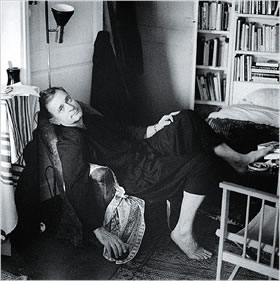
In zijn woning in Parijs
De Duitse schrijver Daniel Kehlmann werd op 13 januari 1975 in München geboren. Zie ook alle tags voor Daniel Kehlmann op dit blog.
Uit: Die Vermessung der Welt
„Nachmittags machte er lange Spaziergänge durch die Wälder. Inzwischen verirrte er sich nicht mehr, er kannte diese Gegend besser als irgend jemand sonst, schließlich hatte er all dies auf der Karte fixiert. Manchmal war ihm, als hätte er den Landstrich nicht bloß vermessen, sondern erfunden, als wäre er erst durch ihn Wirklichkeit geworden. Wo nur Bäume, Moos, Steine und Graskuppen gewesen waren, spannte sich jetzt ein Netz aus Geraden, Winkeln und Zahlen. Nichts, was einmal jemand vermessen hatte, war noch oder konnte je sein wie zuvor. Gauß fragte sich, ob Humboldt das begreifen würde. Es begann zu regnen, er stellte sich zum Schutz unter einen Baum. Das Gras zitterte, es roch nach frischer Erde, und er hätte nirgendwo anders sein wollen als hier.
Humboldts Troß kam nicht gut voran. Seine Abreise war in die Zeit der Schneeschmelze gefallen; ein Planungsfehler, wie er ihm früher nicht unterlaufen wäre. Die Kutschen sanken im Lehm ein und kamen ständig von der durchnäßten Straße ab, immer wieder mußten sie anhalten und warten. Die Kolonne war zu lang, sie waren zu viele Menschen. Schon Königsberg erreichten sie später als berechnet. Professor Bessel empfing Humboldt mit einem Redeschwall, führte sie durch die neue Sternwarte und ließ seinen Gästen die größte Bernsteinkollektion des Landes zeigen. Humboldt fragte ihn, ob er nicht früher mit Professor Gauß gearbeitet habe.
Der Höhepunkt seines Lebens, sagte Bessel, wenn auch nicht einfach. Von dem Moment, als der Fürst der Mathematiker ihm in Bremen empfohlen habe, die Wissenschaft aufzugeben und Koch zu werden oder Hufschmied, falls das nicht schon zu anspruchsvoll für ihn sei, habe er sich lange nicht erholt. Immerhin habe er noch Glück gehabt, sein Freund Bartels in Petersburg habe es mit diesem Mann schlimmer getroffen. Gegen solche Überlegenheit helfe nur Sympathie. Auf der Weiterfahrt nach Tilsit war die Straße vereist, mehrmals brachen die Wagen ein. An der russischen Grenze stand ein Kosakentrupp, der angewiesen war, sie zu begleiten.“
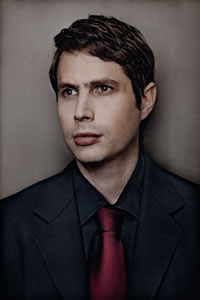
De Amerikaanse schrijver Jay McInerney werd geboren op 13 januari 1955 in Hartford, Connecticut. Zie ook alle tags voor Jay McInerney op dit blog.
Uit: Joy Division’s Heyday
“When I was writing my first novel, Bright Lights, Big City, I pumped myself up with a soundtrack of rotating LPs in the hope of giving my prose a certain energy and beat, in the hope that some of the visceral power of rock and roll would infuse the page. Among those LPs was Joy Division’s Closer, which shared the turntable with the Talking Heads’ Remain in Light, Television, Elvis Costello’s Armed Forces, and Muddy Waters’s Hard Again. I used to play these albums loud, the idea being that I would simultaneously feel the music in my body even as my mind rose to a state of concentration fierce enough to block it out. Though I knew and had even studied the lyrics of all these albums, I was more interested, for the purposes of my writing, in the beat, and the rhythm and the mood. “No language, just sound, that’s all we need to know,” Ian Curtis wrote in “Transmission.” “To synchronize love to the beat of the show.” I don’t know how conscious a program it was, if I’m overstating it in retrospect, but I think I wanted to see if I could infuse the language with some modicum of the sheer sonic power of rock and roll, somehow transmitting the beat and the mood of my favorite rockers.”
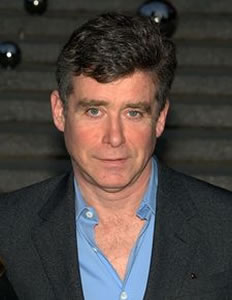
De Amerikaanse schrijfster Lorrie Moore werd geboren op 13 januari 1957 in Glens Falls, New York. Zie ook alle tags voor Lorrie Moore op dit blog.
Uit: How To Become A Writer
“First, try to be something, anything, else.A movie star/astronaut.A movie star
missionary.A movie star/kindergarten teacher.President of the World.Fail miserably.It is best if you fail at an early age — say, fourteen.Early, critical disillusionment is necessary so that at fifteen you can write long haiku sequences about thwarted desire.It is a pond, a cherry blossom, a wind brushing against sparrow wing leaving for mountain.Count the syllables.
Show it to your mom.She is touch and practical.She has a son in Vietnam and a husband who may be having an affair.She believes in wearing brown because it hides spots.She’ll look briefly at your writing, then back up at you with a face blank as a donut.She’ll say: “How about emptying the dishwasher?”Look away.Shove the forks in the fork drawer.Accidentally break one of the freebie gas station glasses.This is the required pain and suffering.This is only for starters.
In your high school English class look only at Mr. Killian’s face.Decide faces are important.
Write a villanelle about pores.Struggle.Write a sonnet.County the syllables:nine, ten, eleven, thirteen.Decide to experiment with fiction.Here you don’t have to count syllables.
Write a short story about an elderly man and woman who accidentally shoot each other in the head, the result of an inexplicable malfunction of a shotgun which appears mysteriously in their living room one night.Give it to Mr. Killian as your final project.When you get it back, he has written on it:”Some of your images are quite nice, but you have no sense of plot.”When you are home, in the privacy of your own room, faintly crawl in pencil beneath his black-inked comments:”Plots are for dead people, pore-face.”
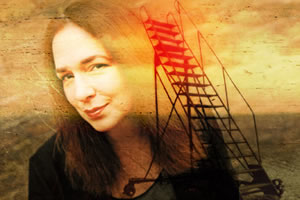
Lorrie Moore (Glens Falls, 13 januari 1957)
De Amerikaanse dichter, schrijver en beeldhouwer Clark Ashton Smith werd geboren in Long Valley (Californië) op 13 januari 1893. Zie ook alle tags voor Clark Ashton Smith op dit blog.
Abandoned Plum-Orchard
Lichen, mistletoe, aloft
In the dying croft,
Leaf the winter trees.
Boys Telling Bawdy Tales
Half-ignorant ribaldries,
Outrageous drolleries
Of infant Rabelais.
The Absence of the Muse
O Muse, where loiterest thou? In any land
Of Saturn, lit with moons and nenuphars?
Or in what high metropolis of Mars—
Hearing the gongs of dire, occult command,
And bugles blown from strand to unknown strand
Of continents embattled in old wars
That primal kings began? Or on the bars
Of ebbing seas in Venus, from the sand
Of shattered nacre with a thousand hues,
Dost pluck the blossoms of the purple wrack
And roses of blue coral for thy hair?
Or, flown beyond the roaring Zodiac,
Translatest thou the tale of earthly news
And earthly songs to singers of Altair?
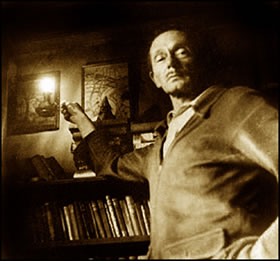
De Litouwse schrijver en vertaler Jurgis Kunčinas werd geboren op 13 januari 1947 in Alytus. Zie ook alle tags voor Jurgis Kunčinas op dit blog.
Uit: Tula (Vertaald door Elizabeth Novickas)
„Your abode, Tūla, hung with faded pictures, where bread molds and flocks of gentle animals graze; it’s crammed with boxes and books, art reproductions, all sorts of notes, clothes, little boxes with voices and memories; a dwelling where the plumbing frequently chokes, and hardened wine in the old goblets of the pictures subsides into reddish crystals; I come to your barely open dry lips, beyond which yawns the black space of the mouth–there where your words, the ones uttered slowly, almost by the syllable, are hiding themselves–all of them are important to me alone; speak, Tūla: they rise, after all, from the very depths, from all of the places inside your flat, patient body, worn out by lethargy, suffering, illnesses, and indifference…
Speak to me, Tūla, tell me and remind me, whisper when I come in the middle of the night, the Old Town dogs whining trustfully as I cut across the ghostly Olandų Street highway and through the damp little yards of Filaretų Street, emerging like a ghost on the Polocko straightway across from the Bernardine graveyard–all this disagreeable little world is linked only to you, Tūla, and the Bernardines, although they’ve been gone a long time now… who says they’re gone? With my footsteps in the slushy snow seemingly drafting a topographic map of this quarter, past the dog market, the pharmacy, the fish and shoe stores, I descend to you, I descend and emerge on the icy shore of the Vilnelė, and the entire old part of the city, lit up by moonlight, really does look like an old city plan, meticulously drawn and colored by some sort of higher being… „
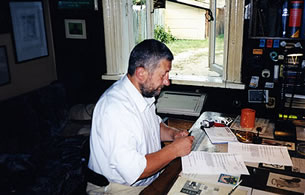
Jurgis Kunčinas (13 januari 1947 – 13 december 2002)
Zie voor nog meer schrijvers van de 13e januari ook mijn tweede blog van 13 januari 2011.
